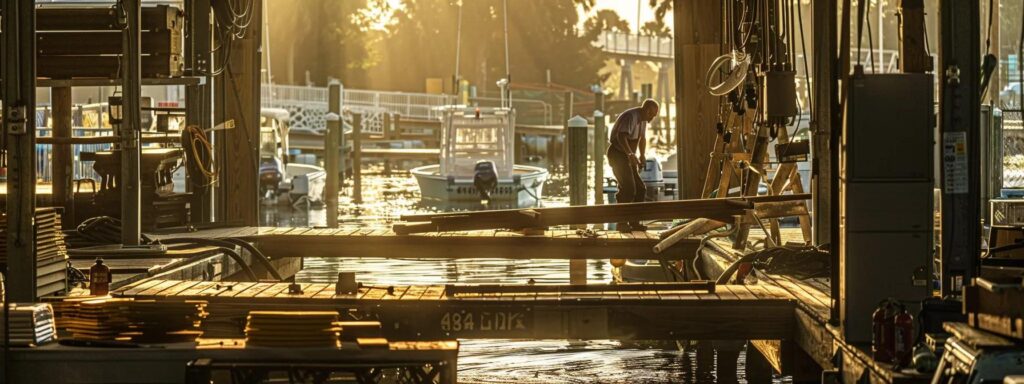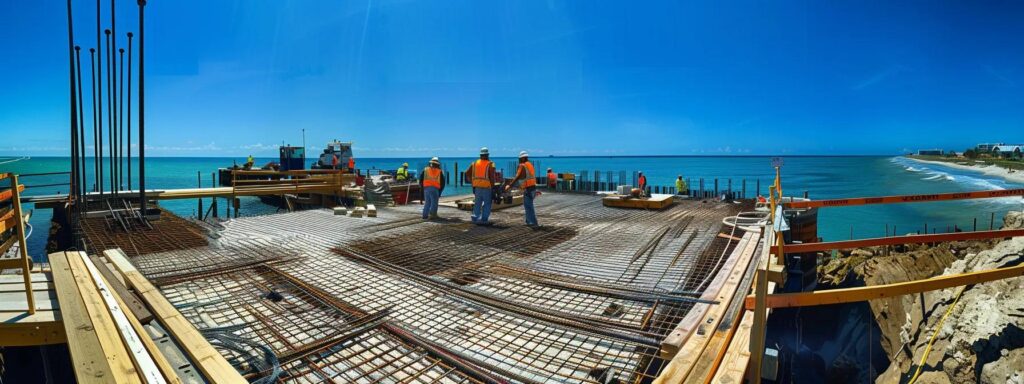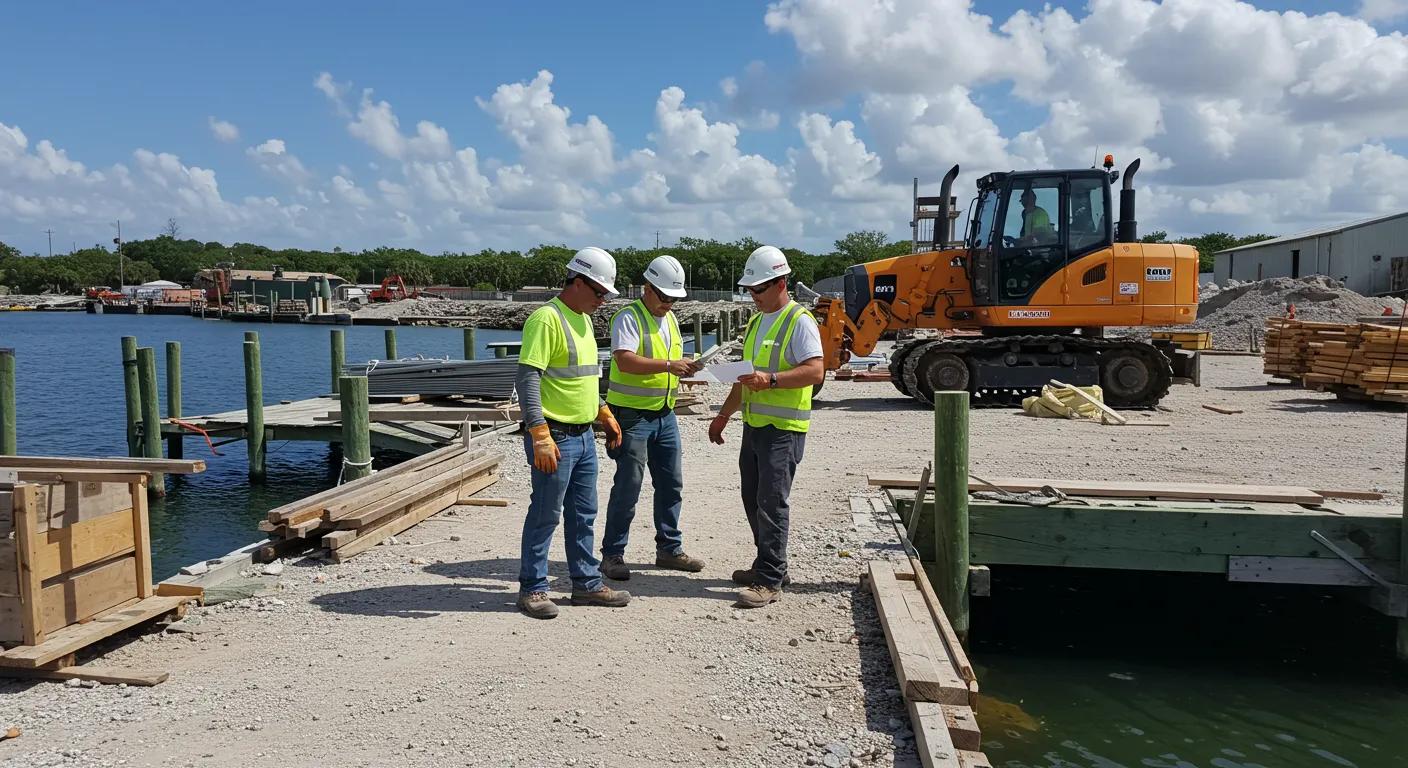What Are Essential Dock Maintenance Strategies?
Regular dock maintenance is critical to safeguarding your waterfront investment while ensuring operational efficiency and safety. This article explains how scheduled inspections, preventative maintenance, and quality materials help keep your docks structurally sound and visually appealing. By following comprehensiveinspection checklists, engaging professionals, and using durable components, you can reduce risks such as corrosion, wear and tear, and accidents. These strategies support compliance with safety regulations, prolong docklongevity, and minimize downtime—all while addressing environmental conditions and crew training.
Understand the Importance of Regular Dock Inspections
Regular dock inspections are the cornerstone of proactive maintenance. They help detect minor issues before they escalate into costly repairs or safety hazards, ensuring your dock remains secure and compliant with safety standards.
Schedule Periodic Dock Inspections to Catch Maintenance Issues
Scheduling periodic inspections—daily, weekly, or monthly depending on dock usage—helps identify signs of wear such as color changes, shifts in structural integrity, and metal corrosion. Planning these checks during low-traffic periods minimizes disruptions while upholding critical safety standards.
Use a Checklist to Evaluate Dock Safety and Functionality
A structured checklist is essential to assess dock surface conditions, structural supports, lighting systems, and loading equipment. It should cover safety features like dock levelers, fenders, and cleats, and address potential hazards such as mildew, sediment buildup, and oil spills. Using the checklist consistently ensures no part of the dock is overlooked.
Identify Wear and Tear Before Severe Damage Occurs
Early detection of wear and tear is vital. Regularly inspect for corrosion on metal components, cracks in concrete, and deterioration in wood. Early intervention—whether applying an environmentally friendly sealant, replacing worn components, or making minor repairs—can extend your dock‘s lifespan.
Document Inspection Findings for Future Reference
Keeping detailed records of inspection dates, findings, and corrective actions is crucial. Documentation helps track damage trends, supports insurance claims, and ensures regulatory compliance, reinforcing your commitment to operational safety.
Engage Professionals for Comprehensive Assessments
While routine inspections can be done in-house, professional dock maintenance experts offer a more technical evaluation. With specialized tools and up-to-date techniques, they can detect hidden issues and recommend improvements for long-term durability and functionality.
Communicate With Staff About Inspection Outcomes
Effective communication with maintenance and operational staff is vital. Sharing clear reports on inspection findings and necessary repairs creates accountability and aligns team efforts toward proactive maintenance, boosting overall safety and productivity.
Implement Preventative Maintenance Strategies for Docks
Preventative maintenance is the next crucial step in keeping your dock in optimal condition. A systematic approach to routine upkeep reduces repair costs, preserves operational efficiency, and protects structural integrity.

Create a Routine Maintenance Schedule for Your Dock
A documented routine maintenance schedule is key. Define daily, weekly, and monthly tasks—such as cleaning, lubricating moving parts, and checking for damage—and include annual or semi-annual professional inspections. Consistency in cleaning away sediment buildup, applying protective coatings, and tightening bolts helps avoid accidents and structural damage.
Inspect and Maintain Cleats and Fenders Regularly
Cleats and fenders secure moored vessels and protect docking equipment from impacts. Regular inspections should focus on detecting wear, corrosion from saltwater, and ensuring secure attachments. Prompt repair or replacement of damaged components prevents accidents and preserves infrastructure.
Clean and Treat Dock Materials to Prevent Corrosion
Regular cleaning to remove salt, mildew, and debris is essential for maintaining dock materials. Washing prevents buildup that can lead to corrosion and wood deterioration. Applying protective coatings and sealants designed for harsh elements further guards against rust and decay, reducing long-term repair costs.
Ensure Proper Lighting and Electrical Maintenance
Good lighting and functional electrical systems are crucial for safety, especially in low-light conditions. Inspections should verify that bulbs are operational, fixtures have waterproof housings, and emergencylighting works. Routine electrical maintenance prevents risks like short circuits and fire hazards.
Monitor Water Levels and Adjust Dock Positioning
Tides, seasonal changes, and storm surges can affect dock stability. Regularly checking the dock’s alignment relative to the waterline and adjusting its positioning is important. Adjustable dock systems offer flexibility to accommodate changing water levels, keeping the platform safe and accessible.
Train Staff on Maintenance Protocols and Safety
Investing in regular staff training ensures everyone understands proper maintenance protocols and safety procedures. Training should cover equipment use, early damage recognition, and the standardized inspectionchecklist. Ongoing workshops and refresher courses help integrate the latest techniques and safety regulations into daily routines.
Choose Quality Materials for Long-Lasting Dock Structures
Using quality materials during dock construction or renovation is vital for longevity and performance. Durable and sustainable components reduce the need for frequent repairs and keep your dock safe and attractive over time.
Research Durable Materials for Dock Construction
Thorough research on available materials is essential. Options include treated wood, composite materials, and high-grade metals that resist corrosion. Comparing traditional materials with modern alternatives can help determine the best fit for your maintenance needs and budget while reducing wear over time.
Consider Environmental Factors in Material Selection
Materials should be chosen based on environmental conditions such as saltwater exposure, heavy traffic loads, and UV exposure. For coastal docks, marine-grade aluminum or specially formulated composites offer resistance to salt corrosion, reducing future maintenance expenses.
Evaluate Coatings and Finishes to Prolong Lifespan
Protective coatings and finishes are key to sustaining dock materials. Specialized paints and sealants for marine or industrial conditions can shield surfaces from corrosion, UV damage, and impact. Selecting the right finish minimizes maintenance efforts and enhances both aesthetic appeal and functionality.
Prioritize Flexible Design for Adaptation Over Time
Flexible dock designs, such as modular or floating systems, allow for easier repairs and upgrades as conditions change. This adaptability minimizes downtime and enables smoother integration of new technologies or materials in the future, making the dock more resilient.
Invest in Sustainable Options for Eco-Friendliness
Eco-friendly, sustainable materials not only promise durability but also lessen environmental impact. Options like recycled plastics or sustainably harvested wood support green construction practices and can lead to long-term cost savings through reduced maintenance and improved efficiency.
Consult Experts on Material Recommendations
Expert installers and material engineers can offer insights into the best materials for your dock’s specific conditions. Their recommendations balance upfront costs with long-term durability and risk mitigation, ensuring you achieve operational efficiency and structural reliability.
Address Environmental Factors Affecting Dock Maintenance
Environmental factors play a significant role in dock durability. A well-planned maintenance strategy must consider these elements to minimize damage and maintain safety.

Assess the Impact of Tides and Currents on Dock Stability
Tides and currents can impose strong forces on dock structures, potentially causing uneven wear and structural failures. Regular assessments of tidal patterns and current strengths help in designing docks with adjustable components and flexible anchoring systems. This proactive approach keeps the dock secure despite fluctuating water conditions.
Monitor Weather Conditions That Can Damage Structures
Weather extremes, including severe storms, high winds, and heavy rainfall, contribute to physical damage such as splintering wood, dislodged fixtures, and water-induced corrosion. Monitoring local weather patterns and planning seasonal adjustments—such as cleaning, re-coating, and reinforcing structures—helps reduce storm-related damage and prolong dock usability.
Implement Erosion Control Measures Where Necessary
Erosion can compromise a dock’s foundation, leading to instability. Measures such as installing seawalls, riprap, or vegetation barriers help stabilize shorelines. Effective drainage and sediment control systems further protect the dock‘s foundation, ensuring it remains level even in high-flow or erosive environments.
Evaluate Water Quality for Potential Damage Risks
Water quality is a critical factor; pollutants, high salt levels, and chemical residues can accelerate corrosion and material degradation. Regular water quality assessments can indicate whether specialized coatings or treatments are necessary. Addressing water quality issues also helps protect the local aquatic environment.
Plan for Seasonal Maintenance Adjustments
Different seasons impose various stresses on dock materials: summer’s UV exposure and warmer water can quicken degradation, while winter conditions require measures against ice and freeze-thaw cycles. A seasonally adjusted maintenance plan—with frequent inspections and targeted treatments—keeps the dock resilient year-round while reducing repair costs.
Incorporate Landscaping to Mitigate Environmental Effects
Strategically placed vegetation can help control erosion and improve water quality. Deep-rooted plants near the dock act as natural barriers against wind and water, enhancing both the structure’s stability and visual appeal. Integrating landscaping with mechanical dock components creates a more sustainable and robust maintenance system.
Train Staff on Effective Dock Maintenance Practices
A well-trained staff is essential for a reliable dock maintenance program. Comprehensive training helps team members identify issues, apply correct repair techniques, and follow safety procedures consistently.
Establish Training Programs on Dock Maintenance Tasks
Develop tailored training programs that cover routine inspection procedures, repair methods, safety protocols, and the proper use of maintenance equipment. Combining hands-on sessions with classroom instruction ensures technical proficiency and reinforces the importance of proactive maintenance.
Create a Maintenance Manual for Reference
A detailed maintenance manual that includes step-by-step procedures, safety guidelines, and troubleshooting tips is an invaluable resource. Regular updates to the manual keep staff informed on best practices and new technologies, empowering them to maintain high standards consistently.
Emphasize Safety Protocols During Maintenance Work
Strong safety protocols are critical. Training should stress the use of personal protective equipment, proper handling techniques, and awareness of common hazards like slippery surfaces and electrical risks. Regular safety drills and refresher courses help reduce accidents and minimize disruptions.
Offer Regular Workshops on New Maintenance Techniques
The maintenance field evolves with new materials, techniques, and equipment. Periodic workshops on innovations—such as environmentally friendly lubricants or advanced corrosion-resistant coatings—ensure that staff are equipped to implement the latest, most efficient practices.
Foster Teamwork for Collaborative Maintenance Efforts
Encourage a collaborative approach by organizing team meetings and joint inspections. Sharing insights and responsibilities leads to quicker issue identification and efficient repairs, while fostering a culture of accountability and collective responsibility.
Evaluate Staff Performance to Improve Practices
Regular performance evaluations and feedback sessions help identify areas for improvement. Monitoring inspection reports and repair efficiency not only recognizes excellent performance but also guides additional training where needed, continuously enhancing maintenance practices.
Utilize Technology for Dock Maintenance Management
Modern technology can significantly boost the precision, efficiency, and predictability of dock maintenance. Real-time monitoring and advanced tools enable you to address issues proactively before they escalate.

Implement Dock Maintenance Management Software Tools
Software tools streamline scheduling, monitoring, and documentation of maintenance activities. Automated reminders, repair history tracking, and comprehensive reports ensure that maintenance tasks are completed consistently, leading to higher operational efficiency and reduced downtime.
Use Drones for Aerial Inspections of Dock Structures
Drones equipped with high-resolution cameras provide an innovative way to inspect hard-to-reach areas of large or complex dock structures. Aerial inspections can quickly reveal hidden weaknesses, cracks, or signs of corrosion, facilitating faster interventions.
Monitor Dock Conditions With Environmental Sensors
Installing environmental sensors provides real-time data on temperature, humidity, and structural stress. Alerts from these sensors allow for immediate action to address issues such as corrosion or material degradation, protecting both the dock and personnel.
Track Maintenance Schedules Through Mobile Apps
Mobile applications enable on-the-go updates and issue reporting. These apps keep maintenance records current and ensure timely execution of tasks—even in remote dock locations—thereby preventing delays and inaccuracies.
Analyze Data to Predict Maintenance Needs Accurately
Data analytics can transform historical maintenance records and sensor data into predictive models. By identifying trends and correlations, you can schedule proactive repairs that minimize unexpected disruptions while extending the life of your dock.
Collaborate With Tech Providers for Tailored Solutions
Working closely with technology providers allows you to develop customized solutions that meet your unique operational needs. Tailored software, integrated sensor networks, and specialized mobile applications enhance reporting detail and scheduling precision, further boosting safety and efficiency.
Table: Comparison of Dock Maintenance Strategies
Before the FAQ section, consider this table summarizing key dock maintenance strategies, their functions, and benefits:
| Maintenance Strategy | Primary Function | Key Benefit | Quantifiable Impact |
|---|---|---|---|
| Regular Inspections | Early damage detection | Reduces repair costs and prevents accidents | Up to 30% reduction in downtime |
| Preventative Maintenance Schedule | Routine care of structural components | Extends lifespan of dock structures | Up to 25% increase in component lifespan |
| Quality Material Selection | Use of durable, corrosion-resistant materials | Lower repair frequency and enhanced safety | 20% improvement in durability |
| Environmental Controls | Mitigation of detrimental weather effects | Improved stability during severe conditions | Up to 15% less structural damage |
| Staff Training Programs | Improvement of maintenance and safety practices | Increased efficiency and safety | 10% reduction in accidents |
| Technology Integration | Use of drones, sensors, and software | Optimized scheduling and precise repairs | Up to 35% improvement in maintenance accuracy |
This table provides a clear overview of the primary strategies, highlighting their functions and benefits.
Frequently Asked Questions
Q: How often should I schedule dockinspections? A: Schedule inspections at least monthly. For docks with heavy usage or harsh coastal exposure, more frequent checks are recommended to spot minor issues before they become major safety hazards.
Q: What factors should I consider when selecting materials for dockconstruction? A: Consider durability, corrosion resistance, environmental impact, and adaptability to local weather. Treated wood, marine-grade aluminum, and high-quality composites are effective choices, especially in coastal environments where saltwater exposure is a concern.
Q: How can technology improve dock maintenancemanagement? A: Technology such as maintenance management software, aerial drones, and environmental sensors streamlines scheduling and monitoring. These tools offer real-time data and predictive analytics, enabling proactive repairs and decreasing downtime.
Q: Why is staff training important for dock maintenance? A: Well-trained staff can implement maintenance protocols consistently and identify issues early. This proactive approach minimizes safety risks, ensures effective repairs, and maintains smooth operations with less unexpected downtime.
Q: What types of preventative maintenance tasks should be included in a routine schedule? A: A comprehensive schedule should include regular cleaning to remove debris and salt buildup, lubrication of moving parts, testing of electrical and lighting systems, and inspections for signs of material wear or corrosion.
Q: How do environmental factors impact dock maintenance? A: Tides, currents, weather conditions, and water quality all affect dock stability and longevity. High salt levels, strong winds, and heavy rains accelerate corrosion and degradation. Implementing erosion control, regular water quality checks, and seasonal maintenance adjustments helps safeguard your dock.
Q: What role do professional inspectors play in dock maintenance? A: Professionals offer specialized expertise and advanced tools to detect hidden issues that might be missed during routine in-house inspections. Their comprehensive assessments ensure that potential hazards are promptly addressed, enhancing overall dock reliability.

Final Thoughts
Regular dock maintenance is essential for ensuring the safety, durability, and efficiency of your maritime infrastructure. Thorough inspections, preventative maintenance strategies, quality materials, and modern technology all contribute to extending the lifespan and functionality of your dock. In addition, well-trained staff and effective communication are vital for a seamless maintenance process. Implement these strategies today to achieve a safer, more efficient dock that supports your operational goals and long-term investment.




